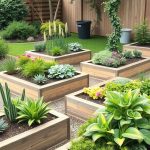Having a sloped backyard can seem like a challenge, but it also opens the door to creative landscaping opportunities. Whether you’re considering a garden, a patio, or even a water feature, there are plenty of ways to make the most of your incline. This guide explores 21 ideas to transform your sloped space into an inviting outdoor retreat that’s both functional and visually appealing.
Choosing the Right Plants for Elevation
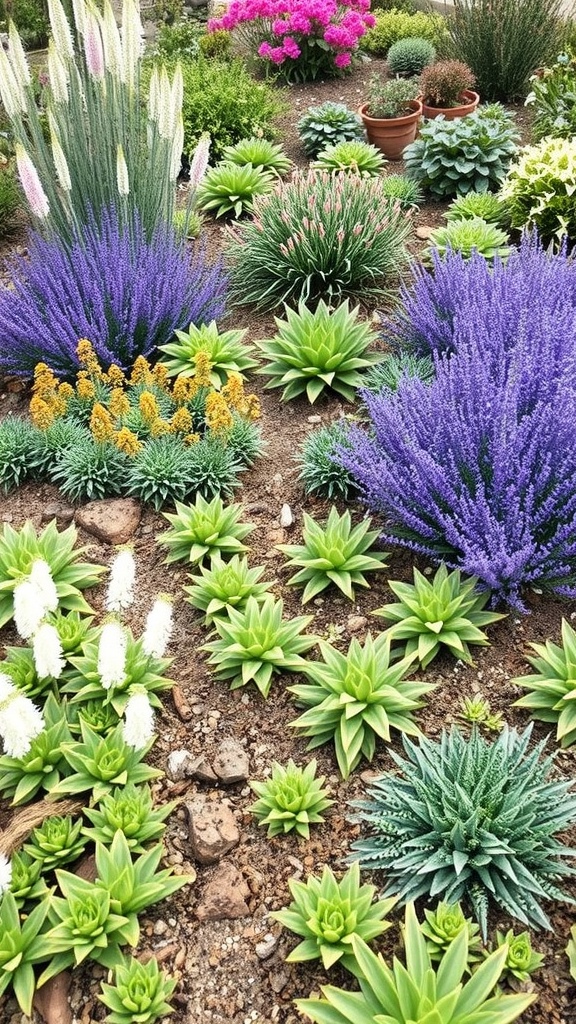
When working with a sloped backyard, picking the right plants is essential. The image showcases a vibrant mix of plants that thrive in such environments. Notice how the various shapes and colors create an inviting space while accommodating the slope.
Succulents and lavender are excellent choices for elevation. They require minimal maintenance and can help prevent soil erosion. The bold purples and greens in the image reflect how these plants can bring life to your yard.
Another thing to consider is plant height. Taller plants like those spiky flowers can add vertical interest, while lower-growing plants fill out the space below. This layering effect is visually appealing and practical for managing water runoff.
Don’t forget to think about the seasons! The combination of evergreen plants and seasonal flowers can keep your backyard vibrant year-round. Plus, mixing textures adds depth, making the garden feel lush and full.
Innovative Deck Designs for Steep Slopes
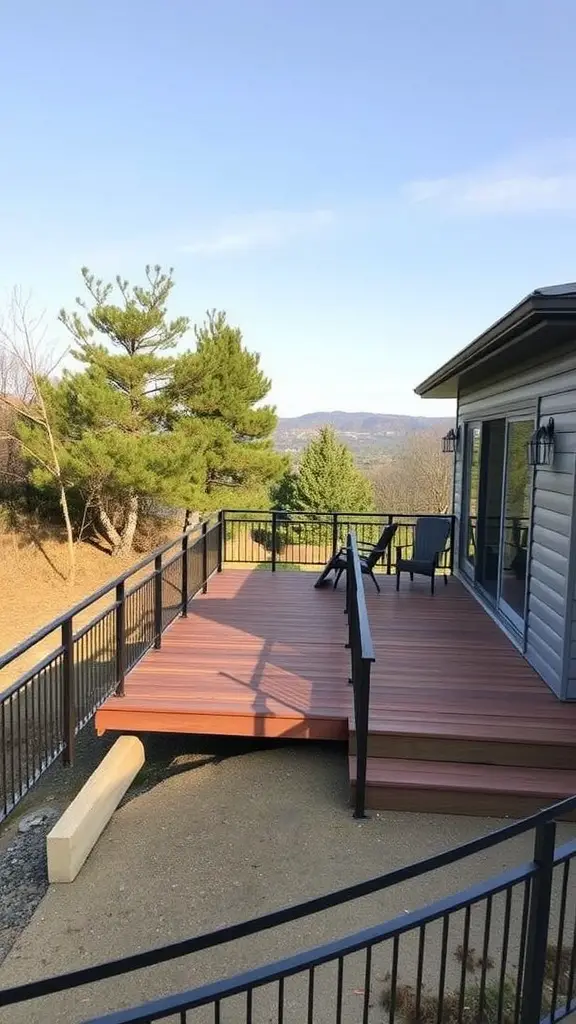
Building a deck on a sloped backyard can be a fun challenge. In the image, you can see a well-designed deck that creatively addresses this issue. The deck features a smooth transition from the house, making it easy to access while maximizing the view of the surrounding landscape.
The use of sturdy railings adds safety and a polished look. The horizontal lines of the deck create a sense of openness, which is crucial in sloped yards. The earthy tones of the decking materials blend beautifully with the natural surroundings, making the space feel inviting.
Incorporating levels or multi-tiered designs is another smart idea for steep slopes. This deck keeps things simple yet functional, showing that even narrower spaces can be utilized efficiently. A small seating area on the deck invites relaxation and enjoyment of the outdoors, transforming a challenging landscape into a cozy retreat.
Creative Landscaping Ideas for Sloped Backyards
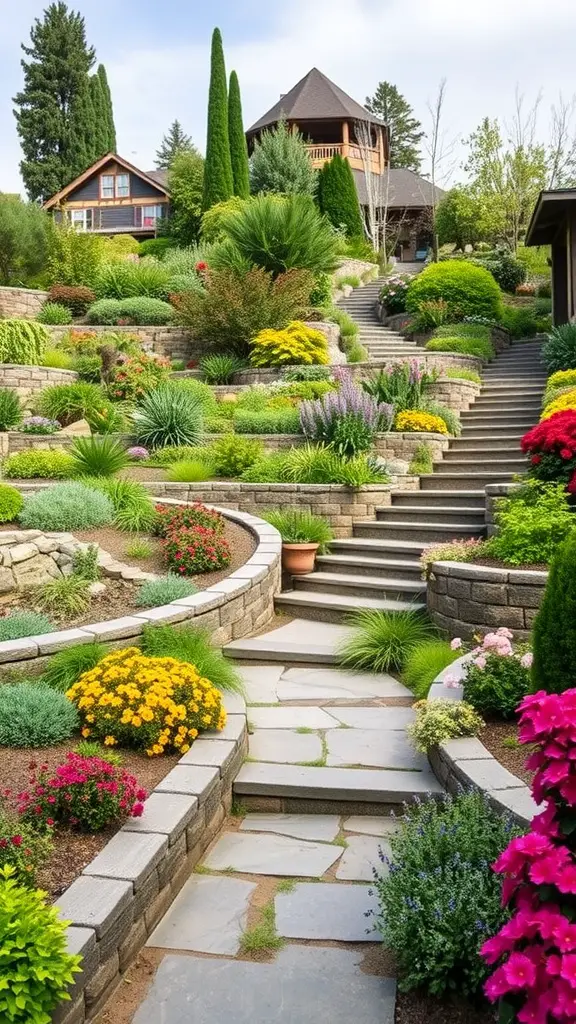
Sloped backyards present unique challenges, but with a little creativity, they can turn into beautiful outdoor spaces. In the image above, you can see how a well-designed slope can be transformed into a lush garden with multiple levels. The use of retaining walls not only adds structure but also helps manage soil erosion.
Notice the winding stone pathway that guides you through the garden. This design invites exploration and makes the slope more accessible. Pathways are essential in sloped areas, providing safe routes to navigate the different levels of your backyard.
The vibrant flowers and varied greenery add a splash of color and texture. Incorporating diverse plant life can create visual interest and provide habitats for local wildlife. Consider mixing perennials and annuals for a garden that blooms at different times of the year.
Adding features like small seating areas or decorative pots can enhance the space further. These elements provide spots to relax and enjoy the beauty of your sloped garden. Overall, landscaping a sloped backyard can blend functionality with beauty, making it a delightful retreat.
Maximizing Privacy with Sloped Terrain
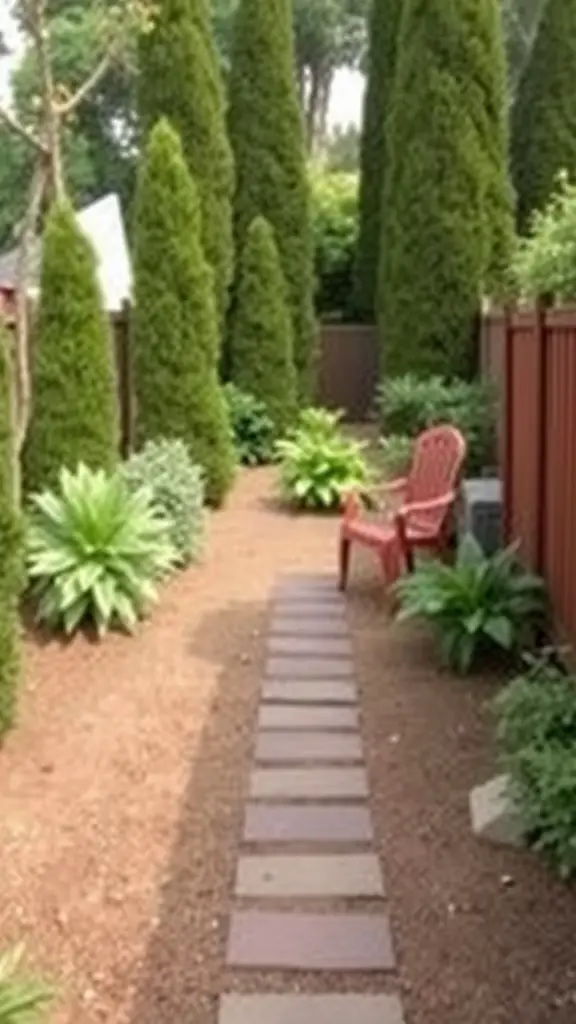
Creating a peaceful retreat in a sloped backyard can be a fun project. This image showcases a lovely pathway lined with lush greenery. The tall trees on either side not only add beauty but also offer a sense of seclusion.
The sloped terrain can be a unique opportunity to design a private space. The combination of different plant heights and textures can block out noise and create a cozy environment. The tall, narrow trees act as a natural fence, enhancing privacy while allowing sunlight to filter through.
Consider using similar landscaping techniques. Incorporating plants that grow tall can act as a natural barrier. This also allows for a sense of enclosure without the need for more intrusive fencing. The pathway invites you in, suggesting that the backyard is not just for looks but also for enjoyment.
When working with a slope, think about how to utilize the space effectively. Use the natural incline to your advantage by creating tiered plantings or seating areas that feel intimate. Adding a comfortable chair, like the one seen in the image, can encourage relaxation and make the area feel like a cozy nook.
Incorporating Water Features in Sloped Areas
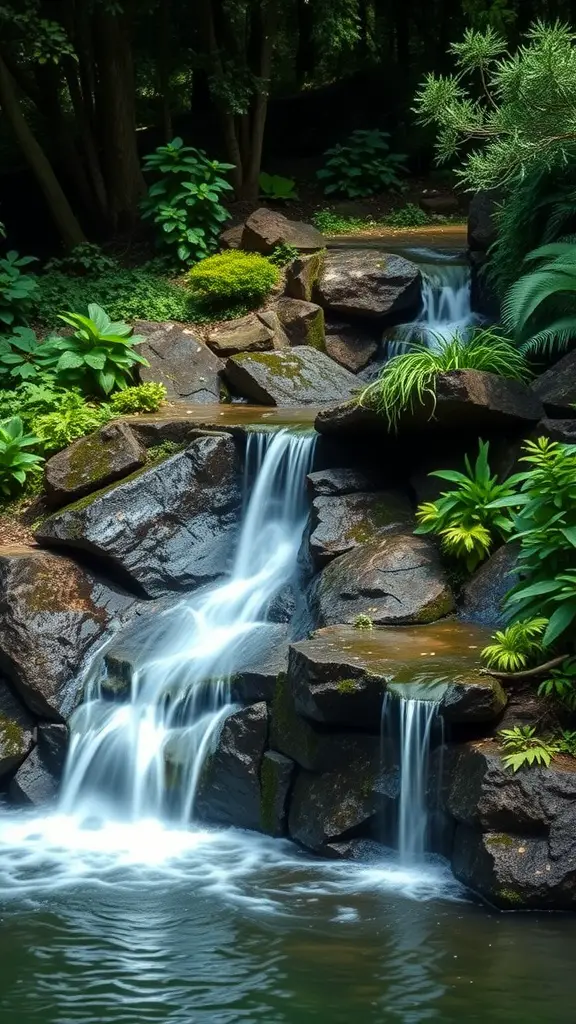
When you have a sloped backyard, adding water features can bring life and charm to the landscape. The image above showcases a beautifully designed waterfall that flows over rocks, creating a serene atmosphere. The sound of water cascading down is not just calming but also helps in masking unwanted noise from the outside world.
Water features like this can also enhance the visual appeal of your backyard. They can serve as a focal point, drawing the eye and inviting guests to explore the area. You can incorporate plants around these features to create a lush, vibrant environment. The contrast of greenery against the flowing water adds depth to your space.
Another benefit of a waterfall or pond is the opportunity it gives you to create different levels in your garden. This can be particularly effective in sloped areas, allowing you to use the natural incline creatively. You could even consider adding fish or aquatic plants to your feature, introducing more life to your garden.
Remember to plan carefully when integrating water features in your sloped backyard. It’s essential to ensure proper drainage to avoid water pooling. With a little thought and creativity, your sloped area can transform into a peaceful retreat where you can enjoy nature’s beauty.
Utilizing Steps and Pathways Effectively
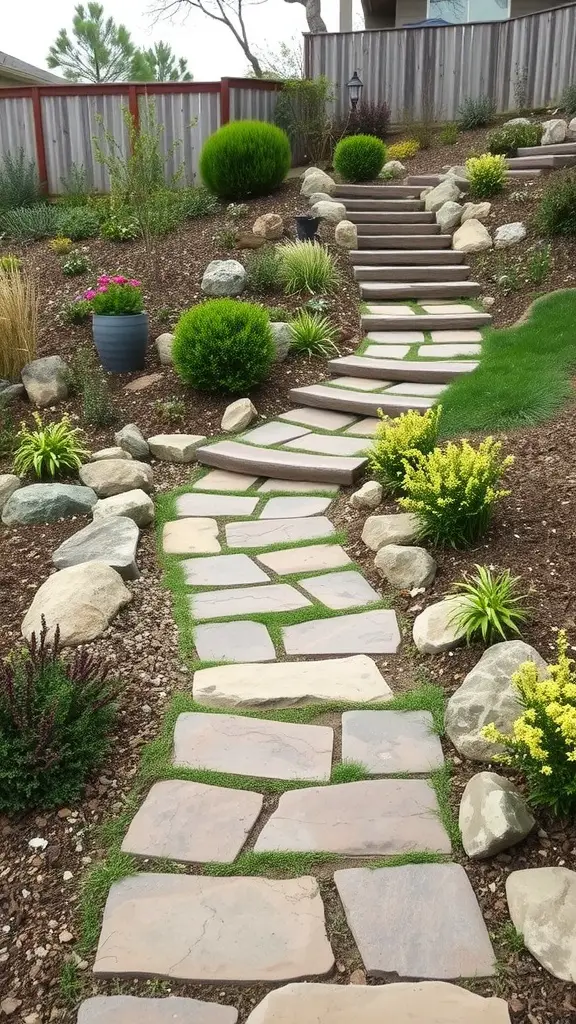
Sloped backyards can be a bit tricky, but with the right steps and pathways, they turn into a beautiful, functional space. The image showcases a well-designed pathway that guides you through the landscape. It’s not just about getting from point A to point B; it’s about enjoying the journey.
The stone steps are neatly placed, leading up the slope. They create a natural flow and invite you to explore the garden further. Each step is wide enough to provide a stable footing, making it easy for everyone to navigate the incline.
Flanking the pathway are lovely shrubs and flowers, adding color and life to the area. These plantings not only enhance the beauty of the space but also help to soften the edges of the stones. Incorporating greenery around the steps can make them feel more integrated into the environment.
Using stones of varying sizes can add character and charm. The mix of textures alongside the smooth stone creates visual interest. Plus, the patches of grass peeking through the stones give a touch of nature, making the pathway feel less rigid.
Lighting is also crucial in a sloped backyard. The lantern by the steps in the image suggests a lovely glow during the evening, ensuring safety while adding a cozy vibe. It’s all about creating a warm atmosphere that welcomes family and friends.
Building Retaining Walls for Stability
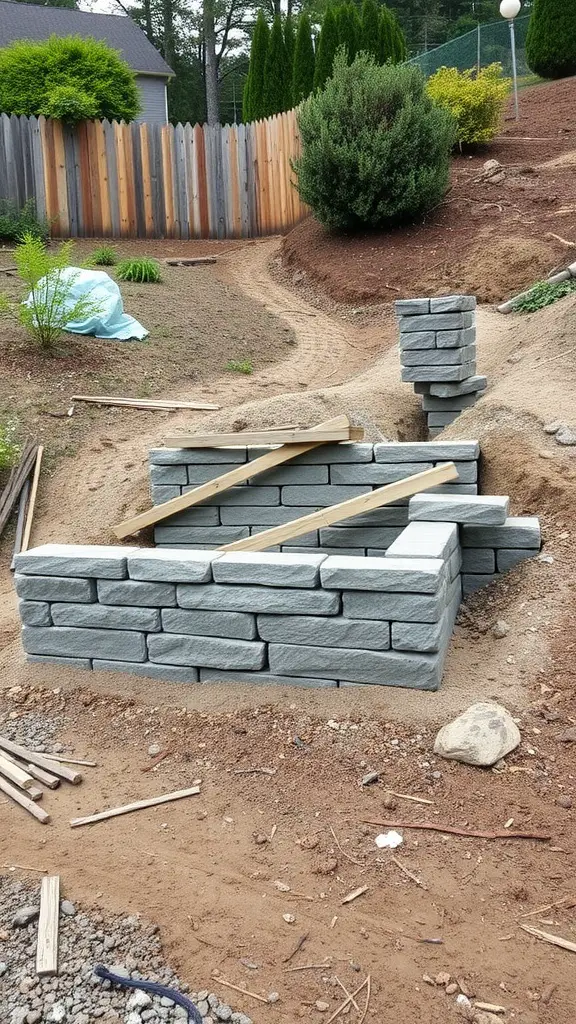
Creating a sloped backyard can be a fun project, but stability is key. One important aspect is building retaining walls. These walls not only hold back soil but also create flat areas for landscaping or other outdoor uses.
The image shows the early stages of building a retaining wall. You can see well-structured stones stacked carefully, providing strength and support. The wall is placed on a base of sand, which helps with drainage and stability. This step is crucial to prevent erosion and keep everything in place.
Using sturdy materials like concrete blocks is a smart choice. They are durable and can withstand the pressures of the soil behind them. It’s also handy to have wooden beams laid across the top. This can help level out the structure while you’re still working.
Don’t forget the importance of planning before you start. Knowing how high and wide the wall should be will guide your construction. Measure the slope carefully; this ensures your retaining walls are effective and look good too.
As you move forward, consider adding plants or garden features around the wall. This not only enhances the aesthetics but can also help with drainage. Retaining walls can be functional and attractive when done right!
Creating Outdoor Living Spaces on a Slope
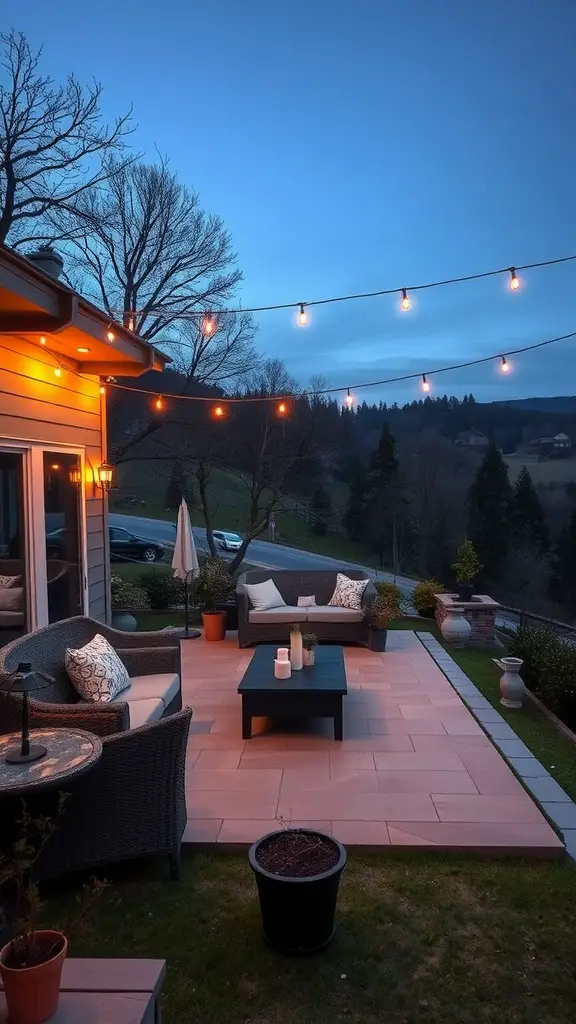
Turning a sloped backyard into a cozy outdoor living space can be an enjoyable project. The image shows a beautifully designed patio area that makes the most of its slope. With stylish seating and thoughtful lighting, it’s a perfect spot for relaxation or entertaining.
The patio features comfortable seating arrangements, which invite you to sit down and unwind. The addition of decorative cushions adds a pop of style. The low table in the center is practical for holding drinks or snacks while you enjoy the view.
One thing to note is the warm glow of the string lights overhead. These lights not only add ambiance but also make the space usable during the evening. They create a welcoming atmosphere that encourages long conversations under the stars.
The landscaping around the patio enhances the overall feel. Potted plants and neatly trimmed shrubs frame the space beautifully. This greenery provides a nice contrast to the hard surfaces of the patio and adds a touch of nature to the environment.
Also, the choice of materials for the patio itself is significant. The paved surface is not only functional but also visually appealing. It helps to define the outdoor space, making it distinct from the sloped yard that surrounds it.
Creating outdoor living spaces on a slope like this one involves careful planning and design. The key is to blend comfort with functionality, ensuring that your backyard serves as an enjoyable extension of your home.
Designing Raised Garden Beds on a Slope
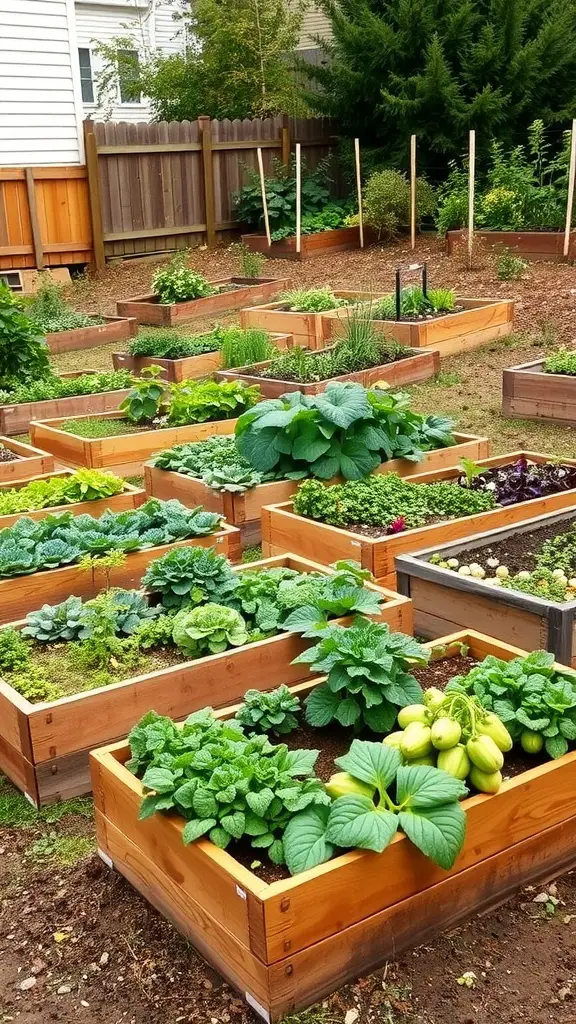
Creating raised garden beds on a slope can be a smart solution for both aesthetics and functionality. In the image, you can see a beautifully arranged set of raised beds nestled into a sloped backyard. This setup not only maximizes space but also helps with drainage, which is crucial for healthy plant growth.
When designing your own raised garden beds, it’s important to consider the layout. The beds in the photo are organized in a way that allows for easy access. This ensures you can tend to your plants without having to navigate steep inclines. Using wooden frames, as shown, adds a natural look that blends well with the surrounding greenery.
Choosing the right plants is essential. Look for varieties that thrive in raised bed conditions. Herbs, leafy greens, and even some root vegetables can do quite well. The lush greenery in the image highlights how a mix of plants can create a vibrant garden.
Don’t forget to consider the soil. Raised beds often require a specific soil mix to ensure proper drainage and nutrient retention. Compost and organic matter can enhance soil health, helping your plants flourish.
Creating a Playground for Kids in a Sloped Backyard
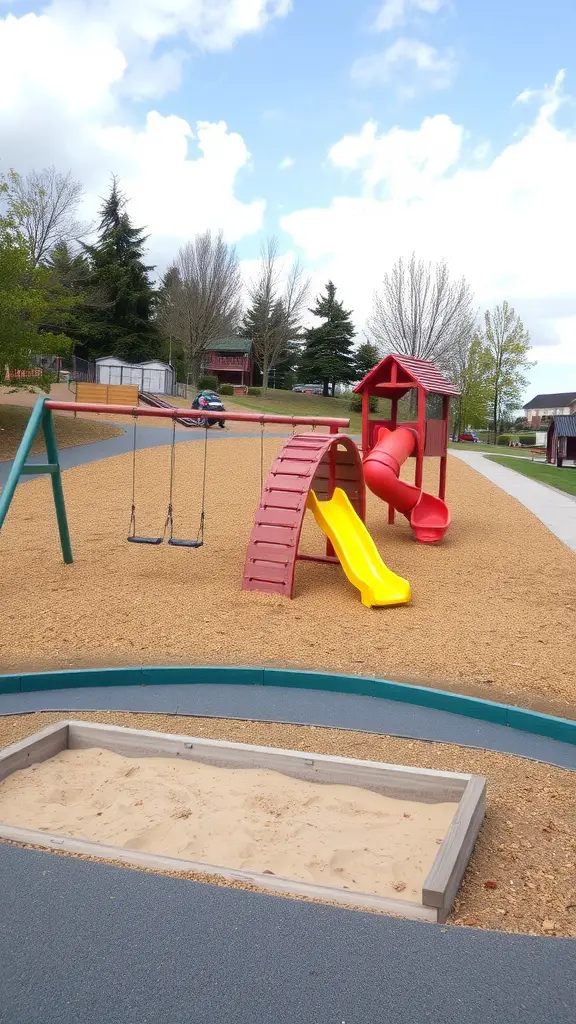
Transforming a sloped backyard into a playground is a fun and exciting project. With some planning, you can create a safe and enjoyable space for kids to play.
The image shows a vibrant playground featuring a slide, swings, and a sandbox. These elements are perfect for keeping kids entertained for hours. The design is functional, making the most of the slope while ensuring safety.
When designing your playground, consider placing equipment that fits the slope. Swings are great since they can be installed at different heights. The slide can also be positioned to allow for a smooth ride down the slope.
Adding a sandbox is another wonderful idea. It encourages imaginative play and can fit nicely into the landscape. Make sure it’s easily accessible for children to dig and build.
Surrounding the play area with soft materials like rubber mulch or grass can help soften any falls. This way, kids can explore their new playground without worry.
Finally, don’t forget about shade! Planting trees or installing a canopy can provide relief on sunny days, making the playground a year-round destination.
Sustainable Practices for Sloped Landscaping
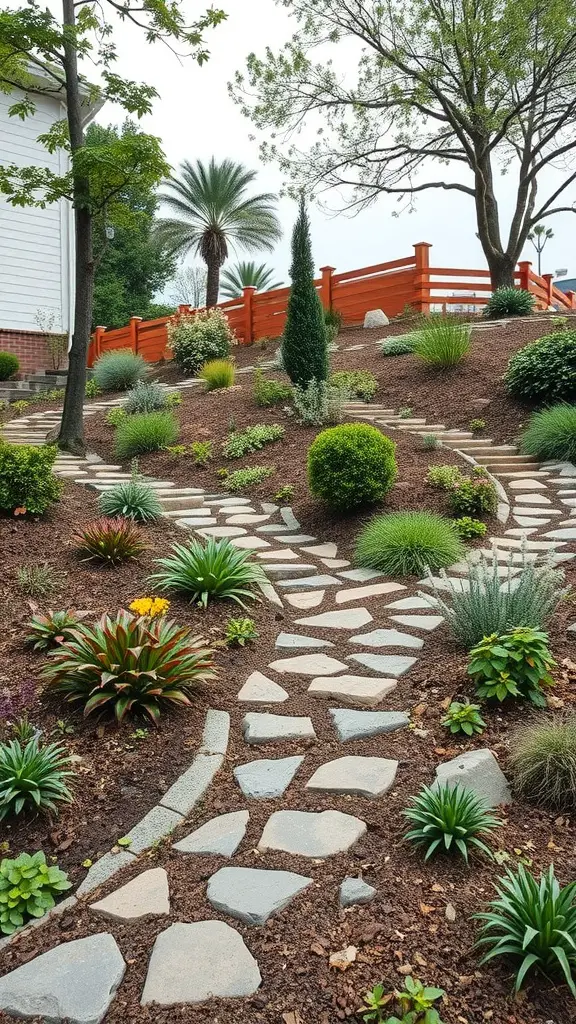
When tackling a sloped backyard, sustainable practices can make a real difference. The image illustrates a beautifully landscaped sloped area, showcasing a mix of plants and natural pathways.
Using native plants is a smart choice for sloped areas. They require less water and maintenance, making them eco-friendly. The vibrant greenery in the image highlights how well these plants thrive in a sloped environment.
Incorporating stone pathways, like those shown, not only adds charm but also reduces erosion. These pathways guide visitors while allowing rainwater to seep into the ground, promoting healthy soil and plant growth.
Mulch is another key element in sustainable sloped landscaping. It helps retain moisture and suppress weeds. The rich, brown color of the mulch in the image beautifully contrasts with the green plants, enhancing the overall aesthetic.
Lastly, consider implementing terracing. This technique can create flat areas for planting and lounging, making the sloped space more usable while preventing runoff. Overall, these sustainable practices ensure that your sloped backyard is both beautiful and functional.
Fire Pit Ideas for Elevated Spaces
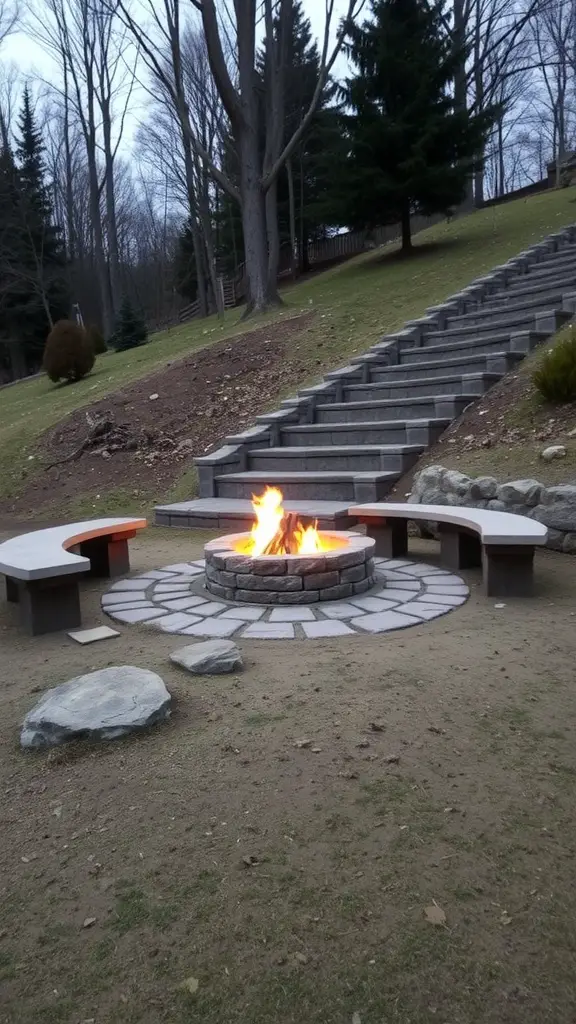
A fire pit can be a cozy centerpiece in any backyard, especially in sloped or elevated spaces. This image showcases a well-designed fire pit area that takes advantage of the land’s natural elevation. The fire pit is surrounded by a circular stone seating arrangement, making it a perfect spot for gathering with friends and family.
Notice how the steps leading up to the fire pit create a welcoming path. They invite guests to explore the backyard while enjoying the scenery. The grassy backdrop and trees add a touch of nature, making the area feel more relaxed and inviting.
When planning a fire pit in a sloped backyard, think about how you want to design the space. Leveling out the ground around the pit can help prevent any safety concerns. Additionally, consider using materials that blend well with your landscape. The stone and wood used in this setup complement the natural surroundings.
Lighting is also key. In the evening, the fire pit becomes a focal point, drawing people in. Surrounding it with comfortable seating encourages relaxation and conversation. You might even want to add some outdoor lighting along the path to enhance safety and ambiance.
Outdoor Lighting Solutions for Slopes
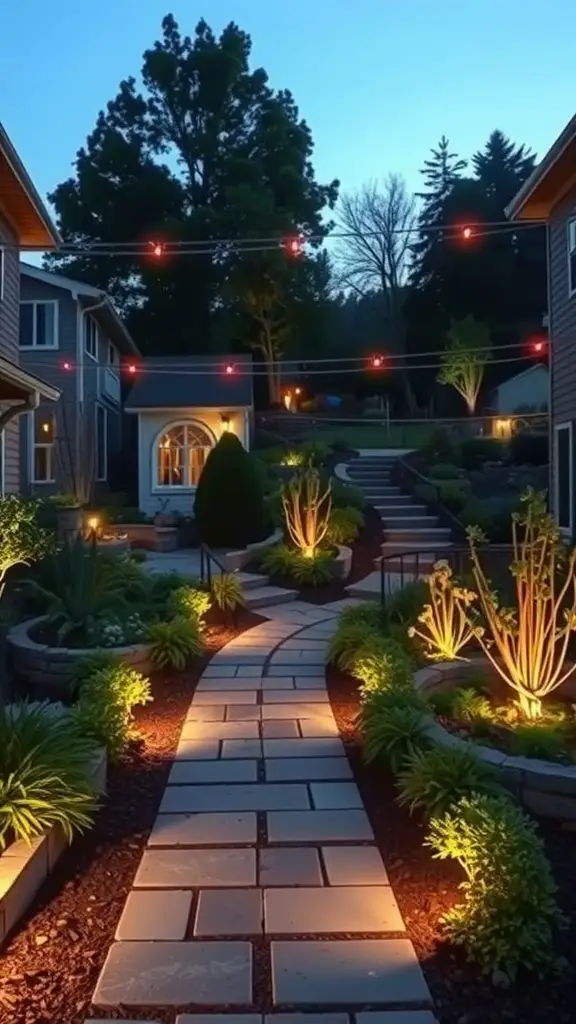
When it comes to sloped backyards, outdoor lighting can transform the space from ordinary to inviting. In the image above, you can see a beautifully illuminated pathway that guides you through a garden. The soft lights along the path create a warm and welcoming atmosphere, perfect for evening gatherings.
Using lighting in a sloped backyard not only enhances aesthetics but also promotes safety. The strategically placed landscape lights highlight the stairs and walkways, making it easier for you and your guests to navigate the space. This is especially important when dealing with uneven terrain.
String lights are another charming option. As shown in the image, they can hang above the pathway, adding a cozy ambiance to your outdoor area. They are perfect for creating a festive vibe for parties or just a relaxing evening outside.
Consider using different types of lights for various effects. Spotlights can draw attention to beautiful plants and trees, while pathway lights guide the way. With a little planning, you can create a layered lighting design that showcases the best features of your sloped yard.
Using Mulch and Ground Cover for Erosion Control
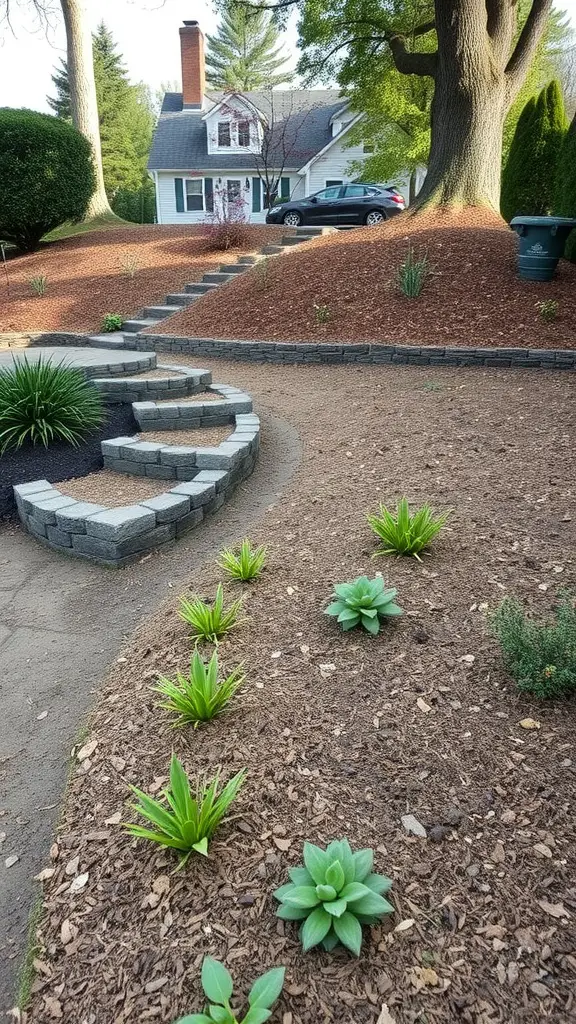
In this beautiful sloped backyard, mulch plays a key role in preventing erosion. The mulch not only adds a natural look but also helps retain moisture in the soil. This is especially important on slopes where water can wash away soil during heavy rains.
Ground cover plants are strategically placed among the mulch, providing additional stability. They spread out, creating a protective barrier against the elements. The combination of mulch and these plants helps anchor the soil, making it less likely to erode.
The pathway made of stone steps adds an inviting touch, guiding visitors through the landscape. As people walk along, they can appreciate the thoughtful design that not only looks good but also protects the environment. It’s a perfect balance of beauty and functionality, showcasing how landscaping can address practical issues like erosion while enhancing the overall aesthetic of the backyard.
Building a Pergola on a Sloped Yard
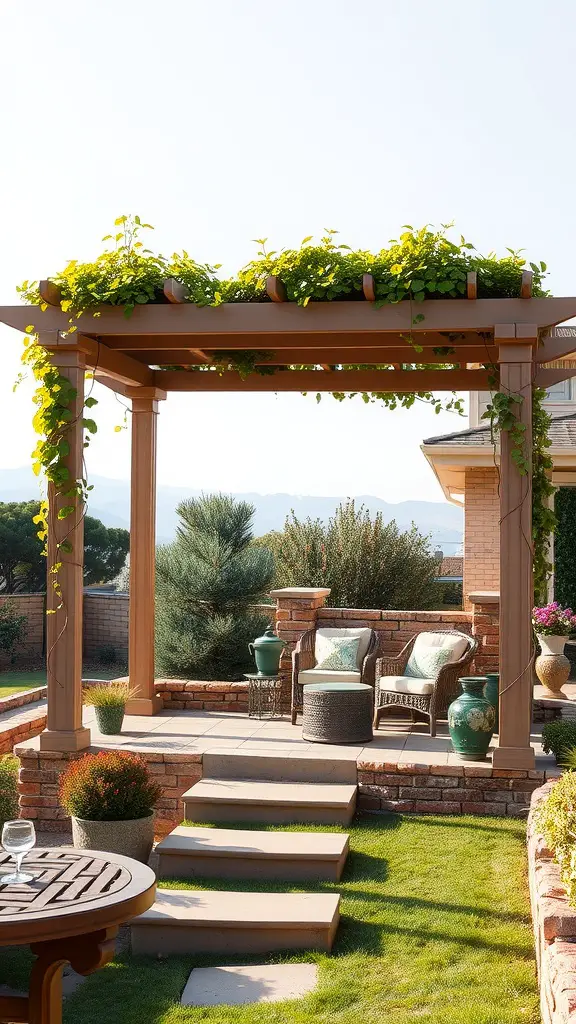
Creating a pergola in your sloped backyard can add charm and functionality to your outdoor space. The image showcases a lovely pergola adorned with lush greenery, providing a beautiful shaded area for relaxation. This setting not only enhances the aesthetic appeal but also makes a cozy spot for gatherings.
When building a pergola on a slope, the first step is to assess the land. You’ll want to determine how the slope impacts the design and foundation. In the image, you can see carefully arranged steps that lead up to the pergola, making it accessible and inviting. It’s essential to create a stable base to ensure the structure remains secure.
Next, consider the materials. A wooden pergola, like the one shown, blends well with natural surroundings. Ensure you choose durable wood that can withstand the elements. The greenery climbing on top adds a vibrant touch, so think about incorporating plants that will thrive in your local climate.
Additionally, lighting can transform your pergola into a magical retreat at night. Simple string lights or lanterns can create a warm ambiance. The cozy seating area visible in the image invites relaxation and enjoyment, making it a perfect spot to unwind after a long day.
Finally, don’t forget to personalize your space. Whether it’s decorative cushions or potted plants, adding your touch will make the pergola feel like home. Building a pergola in a sloped yard may require a bit of planning, but the payoff is well worth it!
Creating Zones for Different Activities
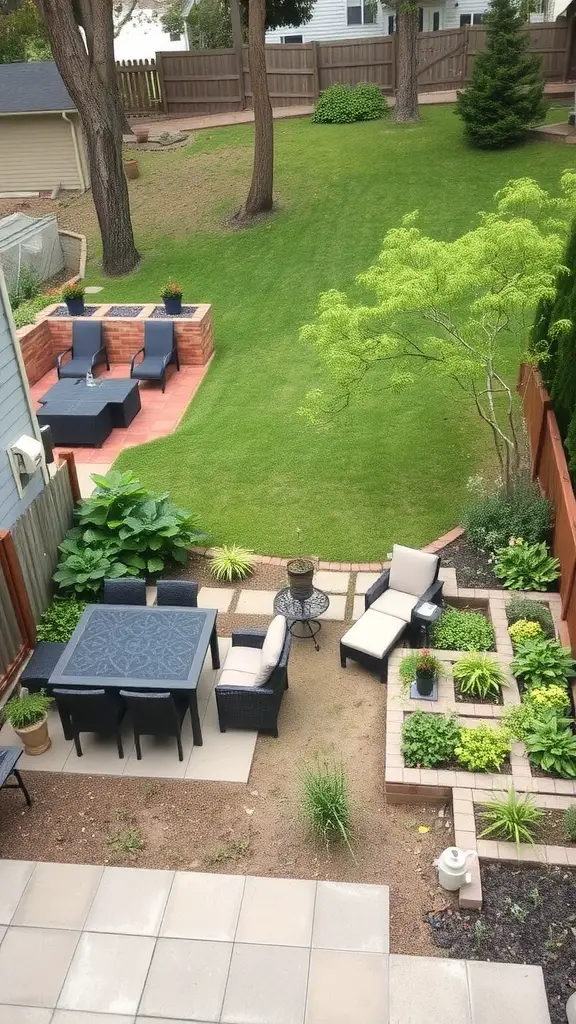
In a sloped backyard, creating distinct zones can enhance both functionality and enjoyment. This image shows how a thoughtfully designed space accommodates various activities. The separated areas invite relaxation and socializing, making the most of the available terrain.
The patio area is perfect for gatherings. With comfortable seating around a central table, it’s an ideal spot for meals, games, or just hanging out with friends. The outdoor furniture is both stylish and practical, making it easy to enjoy the outdoors without sacrificing comfort.
Nearby, a lush garden area provides a cozy, tranquil space. This garden features well-maintained plants and decorative elements, creating a peaceful retreat. It encourages gardening activities and offers a great space for quiet reflection or reading.
Each zone is clearly defined, yet they flow together nicely, making it easy to transition from one area to another. This design strategy not only maximizes space but also enhances the overall atmosphere, allowing for a variety of experiences, from lively gatherings to peaceful moments alone.
Integrating Boulders and Natural Stone
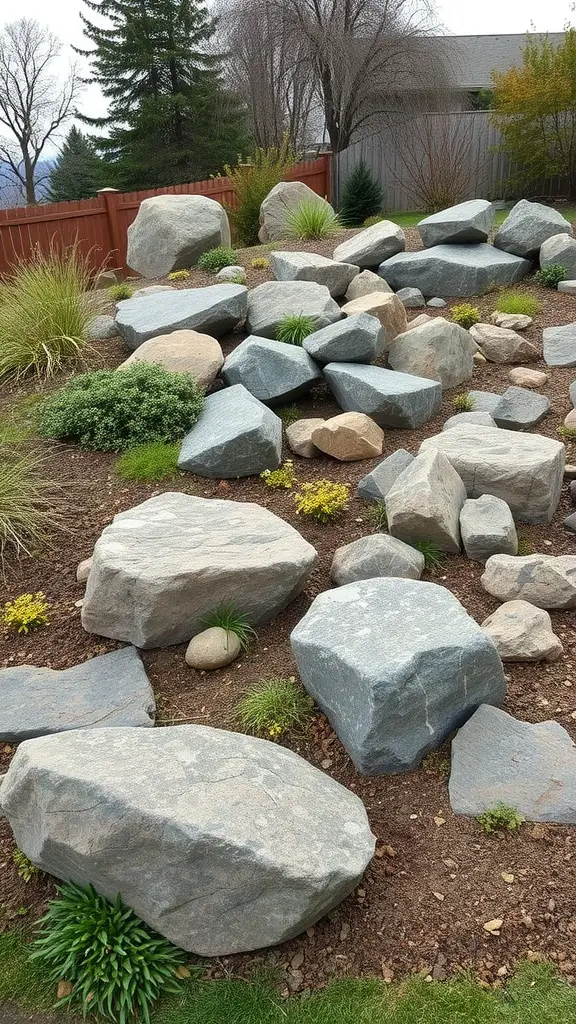
In a sloped backyard, incorporating boulders and natural stone can create a stunning landscape that feels both inviting and harmonious with nature. The image shows a variety of rocks arranged thoughtfully across a sloped area, blending beautifully with the surrounding greenery.
Using boulders not only adds visual interest but also helps with erosion control. They can act as natural barriers, guiding water flow and preventing soil washout. Selecting stones in various sizes and shapes, as seen in the picture, enhances the natural look, making it feel like a part of the landscape rather than a man-made feature.
Additionally, integrating plants like grasses and small flowers around the rocks adds color and texture. This mix of hard and soft elements creates a balanced aesthetic. Low-maintenance plants work well in these settings, thriving alongside the stones without needing constant attention.
Incorporating natural stone paths can also enhance functionality. They provide a safe route through the garden while adding to the overall charm. It’s all about creating a space that feels connected to the environment, allowing you to enjoy your backyard year-round.
Creating a Scenic Viewpoint on a Slope
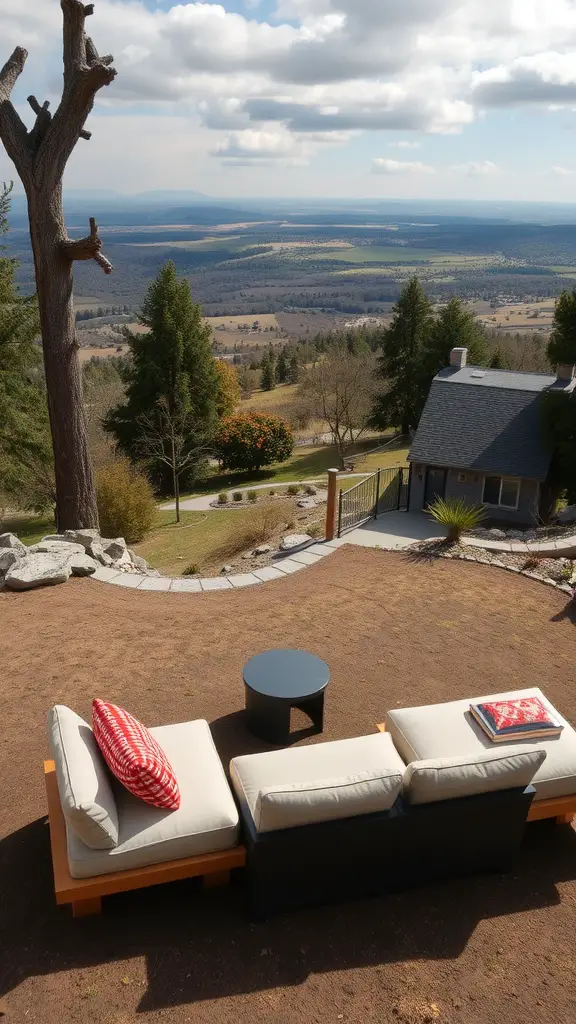
Transforming a sloped backyard into a scenic viewpoint can be a delightful project. In the image, we see a cozy seating arrangement that invites relaxation while overlooking a breathtaking landscape.
The slope allows for a unique elevation that enhances the view, making it a perfect spot for morning coffee or evening chats. The cushions are designed for comfort, and the small table offers a convenient place for drinks or a good book.
The natural surroundings, with trees and an open field in the background, create a calming atmosphere. Imagine enjoying sunsets from this vantage point, where every moment can feel special. The space is not just about aesthetics; it encourages a connection with nature.
To maximize the beauty of a sloped backyard, consider landscaping elements like native plants or decorative stones. These can complement the seating area and tie everything together. A well-placed fire pit could also enhance gatherings, making it a go-to spot for family and friends.
Seasonal Color Changes in Sloped Landscapes
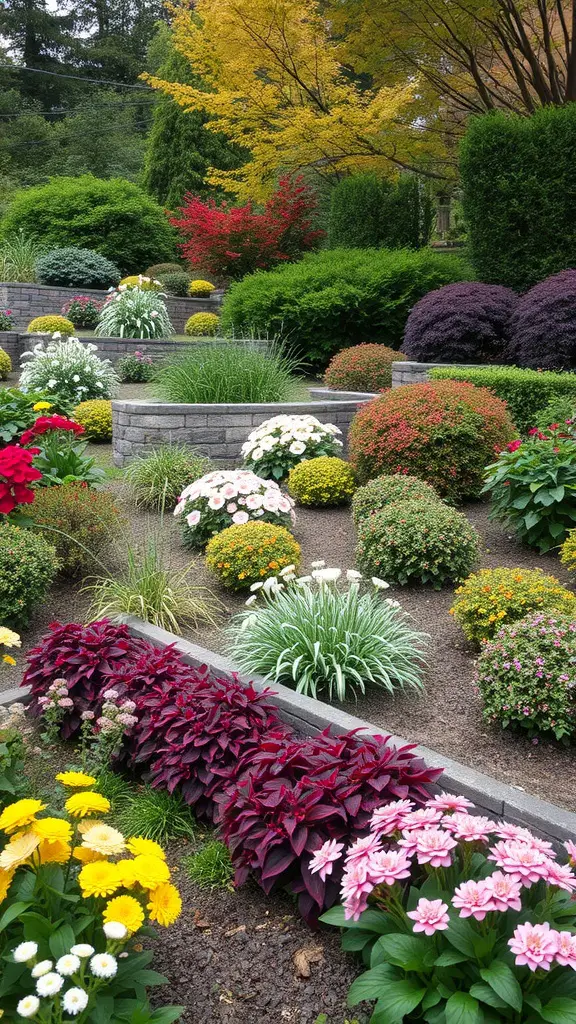
Sloped backyards can be a delightful canvas for seasonal changes. The image shows a beautifully arranged landscape where vibrant flowers and lush greenery create a dynamic scene. As the seasons shift, the colors of this sloped garden will transform, showcasing nature’s palette.
In spring, the flowers bloom in bursts of yellows, pinks, and whites. These lively colors signal the end of winter and bring a sense of renewal. As summer arrives, the foliage becomes thicker, adding depth to the landscape. The rich greens contrast beautifully with the bright flower beds.
Autumn is when the garden truly shines. The trees in the background display stunning golden and red hues, while the flowers begin to fade. This seasonal change provides a warm, inviting feel to the space. Winter brings a quieter look, as the landscape often rests, but even then, the structure of the garden stands strong, ready for the cycle to begin again.
Each season brings its own character to a sloped backyard, making it an ever-changing landscape. It’s a reminder that nature is always in motion, and a well-planned garden can reflect that beauty throughout the year.
Vertical Gardening Solutions for Limited Space
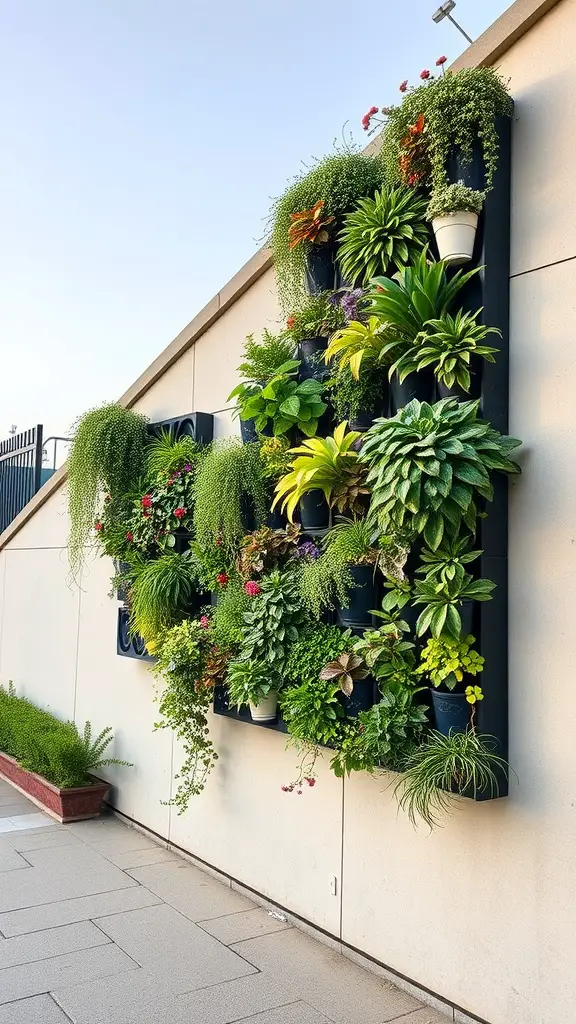
When space is tight, vertical gardening can transform any small area, especially in a sloped backyard. The image showcases a beautiful vertical garden mounted on a wall, brimming with a variety of lush plants. This not only adds greenery but also makes a statement in outdoor design.
Using vertical planters, you can maximize your growing area by going up instead of out. This method is ideal for those who want to enjoy gardening without needing a large plot. The wall-mounted garden in the picture illustrates how you can create a vibrant display using different plant types, colors, and textures.
Additionally, incorporating vertical gardens into your backyard can improve air quality and enhance your space’s aesthetic appeal. By selecting plants that thrive in your local climate, you can create a sustainable green wall that requires less maintenance. It’s not just about looks; it’s about creating a little urban jungle in your own home!
Incorporating Steps and Terraces for Accessibility
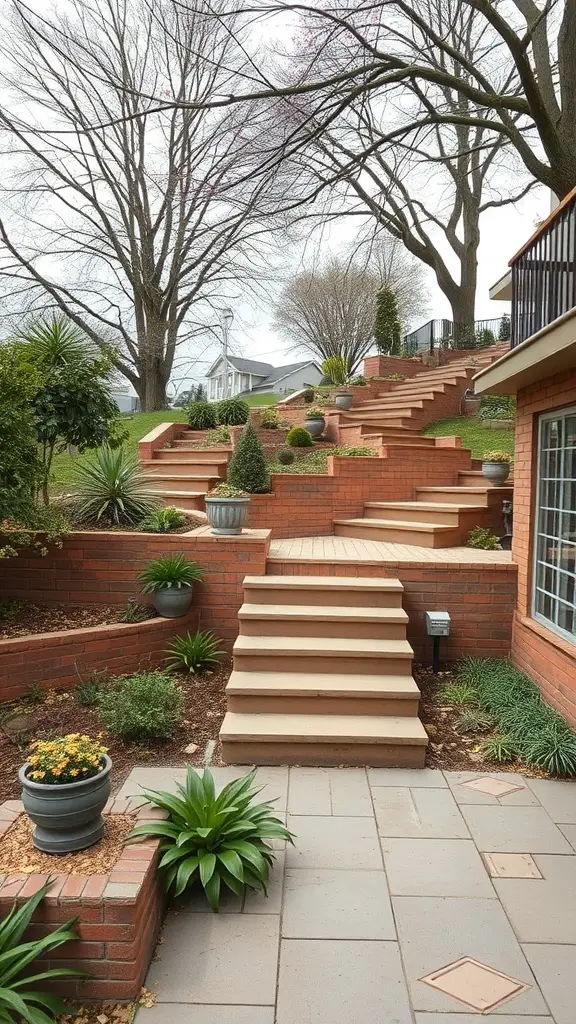
When dealing with a sloped backyard, adding steps and terraces can significantly enhance accessibility. This image showcases a beautifully designed slope with multiple sets of steps, making it easy to navigate the area.
The use of well-placed terraces breaks up the incline, allowing for easy movement between different levels. These steps are not just functional; they add visual interest to the landscape. Each section can be adorned with plants, creating a pleasing aesthetic.
Incorporating greenery around the steps enhances the atmosphere. Potted plants and small shrubs provide color and texture, making the space feel more inviting. If you’re considering a similar design, think about how plants can complement the structure of your steps.
Creating a pathway with ample space between steps makes it accessible for everyone. Whether you’re carrying items or just enjoying a walk, these features contribute to a friendly outdoor space. Make sure your steps are wide enough to accommodate different needs.
Lastly, consider the material for the steps. Choosing durable, slip-resistant materials is essential for safety, especially in wet conditions. All these elements together create an environment that is not only functional but also a pleasure to be in.




